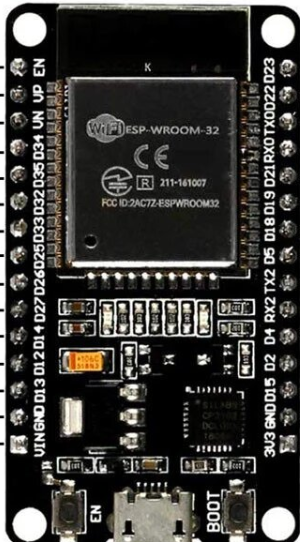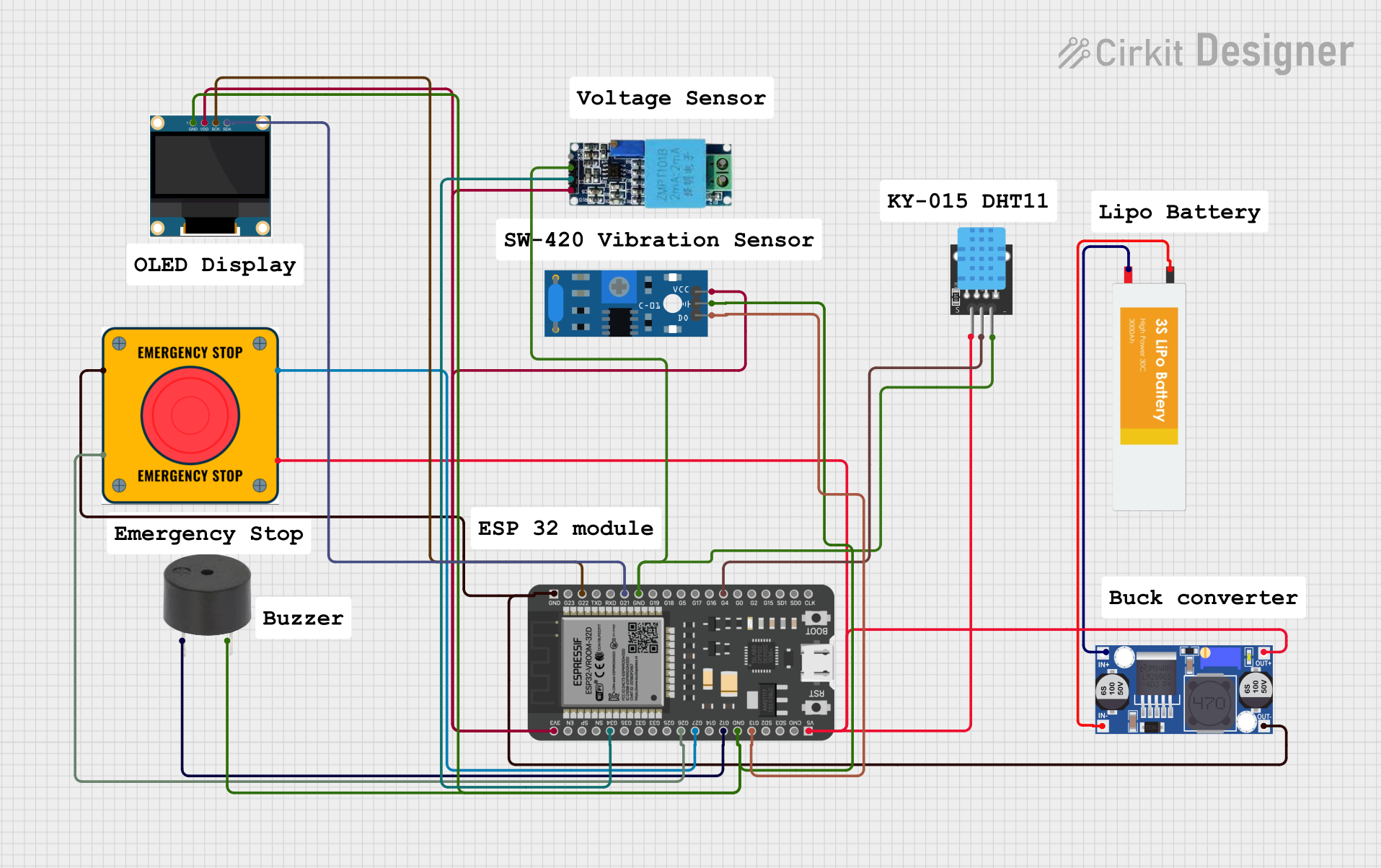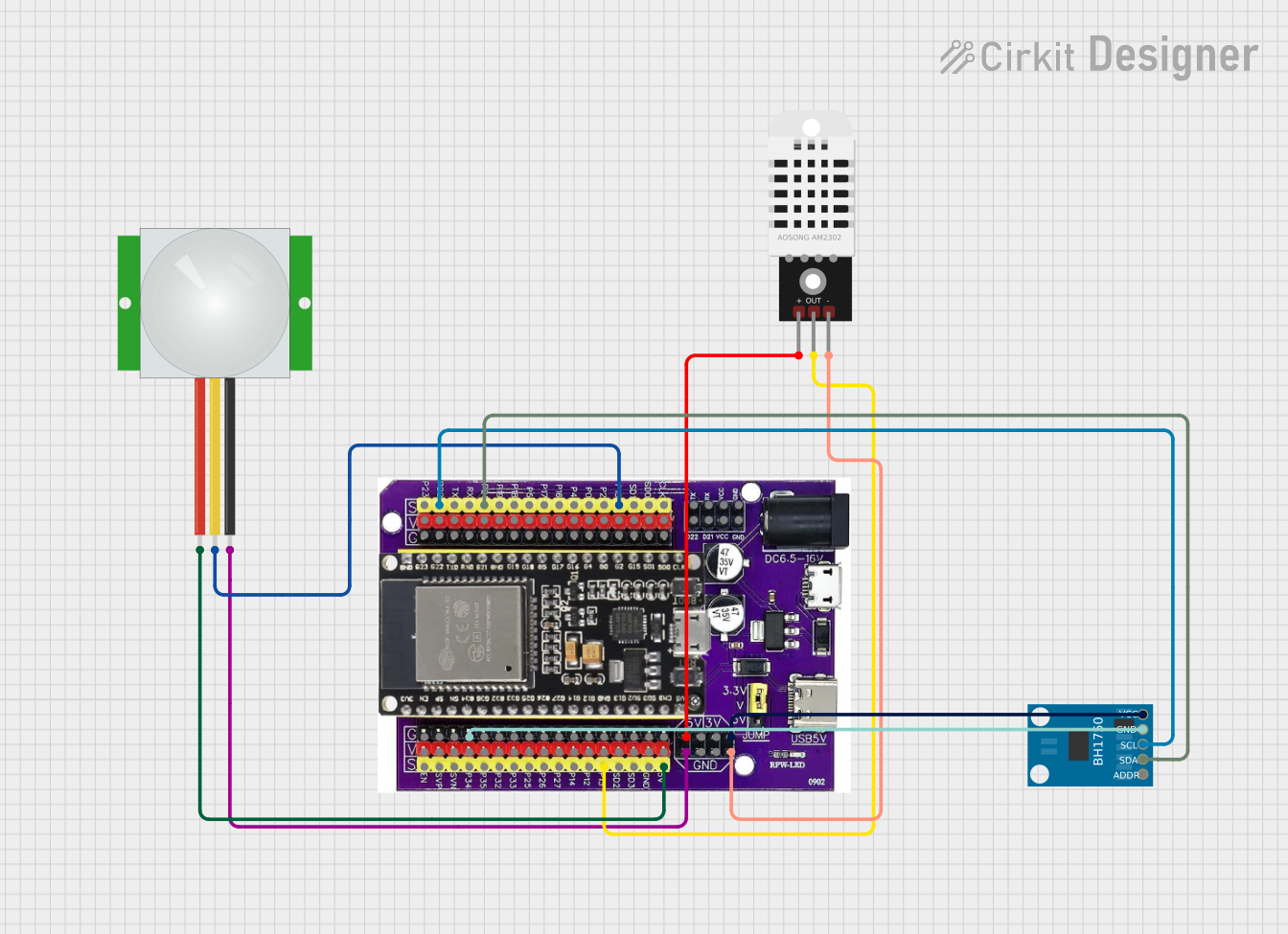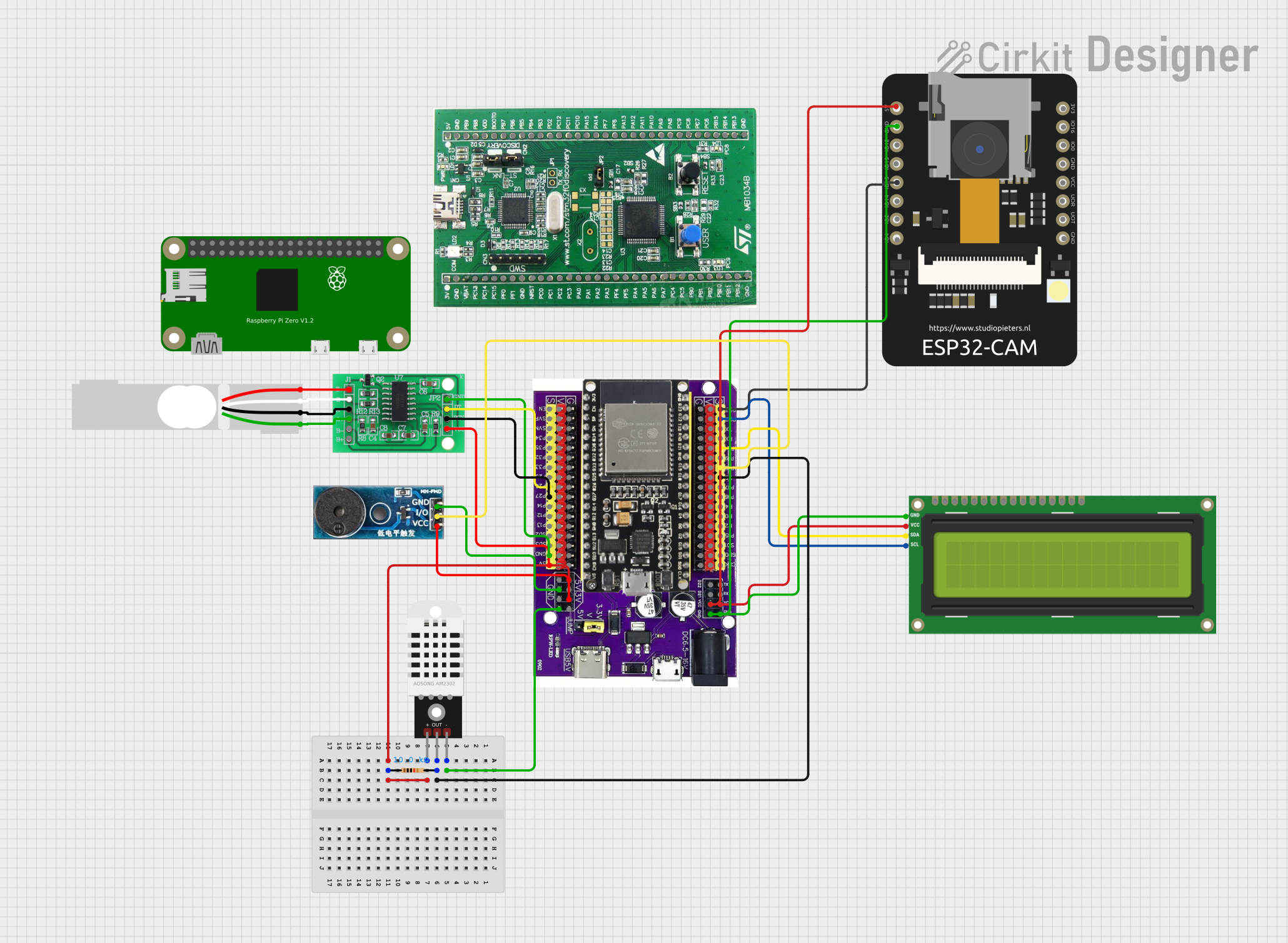
How to Use esp32: Examples, Pinouts, and Specs

 Design with esp32 in Cirkit Designer
Design with esp32 in Cirkit DesignerIntroduction
The ESP32, manufactured by Espressif Systems, is a low-cost, low-power system on a chip (SoC) with integrated Wi-Fi and Bluetooth capabilities. It is widely used in Internet of Things (IoT) applications, embedded systems, and smart devices. The ESP32 offers a powerful dual-core processor, a rich set of peripherals, and extensive connectivity options, making it a versatile choice for developers.
Explore Projects Built with esp32

 Open Project in Cirkit Designer
Open Project in Cirkit Designer
 Open Project in Cirkit Designer
Open Project in Cirkit Designer
 Open Project in Cirkit Designer
Open Project in Cirkit Designer
 Open Project in Cirkit Designer
Open Project in Cirkit DesignerExplore Projects Built with esp32

 Open Project in Cirkit Designer
Open Project in Cirkit Designer
 Open Project in Cirkit Designer
Open Project in Cirkit Designer
 Open Project in Cirkit Designer
Open Project in Cirkit Designer
 Open Project in Cirkit Designer
Open Project in Cirkit DesignerCommon Applications and Use Cases
- IoT devices and smart home automation
- Wearable electronics
- Wireless sensor networks
- Industrial automation
- Robotics and drones
- Prototyping and educational projects
Technical Specifications
The ESP32 Dev Module is a feature-rich development board based on the ESP32 SoC. Below are its key technical specifications:
Key Technical Details
| Parameter | Specification |
|---|---|
| Manufacturer | Espressif Systems |
| Part ID | ESP32 Dev Module |
| Processor | Dual-core Xtensa® 32-bit LX6 CPU |
| Clock Speed | Up to 240 MHz |
| Flash Memory | 4 MB (varies by module) |
| SRAM | 520 KB |
| Wi-Fi | 802.11 b/g/n (2.4 GHz) |
| Bluetooth | v4.2 BR/EDR and BLE |
| Operating Voltage | 3.3 V |
| Input Voltage Range | 5 V (via USB) or 3.3 V (via pins) |
| GPIO Pins | 34 |
| ADC Channels | 18 (12-bit resolution) |
| DAC Channels | 2 (8-bit resolution) |
| Communication Interfaces | UART, SPI, I2C, I2S, CAN, PWM |
| Power Consumption | Ultra-low power (varies by mode) |
Pin Configuration and Descriptions
The ESP32 Dev Module has a variety of pins for different functionalities. Below is a summary of the pin configuration:
| Pin Name | Functionality | Description |
|---|---|---|
| VIN | Power Input | Accepts 5 V input via USB or external source. |
| GND | Ground | Common ground for the circuit. |
| 3V3 | Power Output | Provides 3.3 V output for peripherals. |
| EN | Enable | Resets the chip when pulled low. |
| GPIO0 | Boot Mode Selection | Used for flashing firmware. |
| GPIO2 | General Purpose I/O | Can be used as a standard GPIO pin. |
| GPIO12 | ADC, Touch Sensor | Supports analog input and capacitive touch. |
| GPIO13 | PWM, ADC, Touch Sensor | Supports PWM, analog input, and touch sensing. |
| GPIO21 | I2C SDA | Data line for I2C communication. |
| GPIO22 | I2C SCL | Clock line for I2C communication. |
| TX0 | UART Transmit | Transmits data via UART. |
| RX0 | UART Receive | Receives data via UART. |
Note: Not all GPIO pins are available for general use. Some are reserved for specific functions or have limitations.
Usage Instructions
How to Use the ESP32 in a Circuit
Powering the ESP32:
- Connect the ESP32 to a 5 V power source via the USB port or supply 3.3 V directly to the 3V3 pin.
- Ensure the power source can provide sufficient current (at least 500 mA).
Connecting Peripherals:
- Use the GPIO pins to connect sensors, actuators, or other peripherals.
- For analog sensors, connect them to ADC-capable pins (e.g., GPIO12, GPIO13).
Programming the ESP32:
- Install the Arduino IDE or ESP-IDF (Espressif IoT Development Framework).
- Select the correct board (e.g., "ESP32 Dev Module") in the IDE.
- Connect the ESP32 to your computer via USB and upload your code.
Wi-Fi and Bluetooth Setup:
- Use the built-in libraries (e.g.,
WiFi.hfor Wi-Fi andBluetoothSerial.hfor Bluetooth) to configure connectivity.
- Use the built-in libraries (e.g.,
Important Considerations and Best Practices
- Voltage Levels: The ESP32 operates at 3.3 V logic levels. Avoid connecting 5 V signals directly to GPIO pins.
- Boot Mode: Ensure GPIO0 is pulled low during boot to flash firmware.
- Power Supply: Use a stable power source to avoid unexpected resets or malfunctions.
- Heat Management: The ESP32 may heat up during operation. Ensure proper ventilation if used in enclosed spaces.
Example Code for Arduino UNO Integration
Below is an example of using the ESP32 to connect to a Wi-Fi network:
#include <WiFi.h> // Include the Wi-Fi library
// Replace with your network credentials
const char* ssid = "Your_SSID";
const char* password = "Your_PASSWORD";
void setup() {
Serial.begin(115200); // Start serial communication at 115200 baud
delay(1000); // Wait for a second to stabilize
Serial.println("Connecting to Wi-Fi...");
WiFi.begin(ssid, password); // Start Wi-Fi connection
while (WiFi.status() != WL_CONNECTED) {
delay(500); // Wait for connection
Serial.print("."); // Print progress
}
Serial.println("\nWi-Fi connected!");
Serial.print("IP Address: ");
Serial.println(WiFi.localIP()); // Print the assigned IP address
}
void loop() {
// Add your main code here
}
Note: Replace
Your_SSIDandYour_PASSWORDwith your Wi-Fi network credentials.
Troubleshooting and FAQs
Common Issues and Solutions
ESP32 Not Connecting to Wi-Fi:
- Ensure the SSID and password are correct.
- Check if the router is within range and supports 2.4 GHz Wi-Fi (ESP32 does not support 5 GHz).
Upload Fails in Arduino IDE:
- Verify the correct board and COM port are selected.
- Hold the "BOOT" button on the ESP32 while uploading the code.
Random Resets or Instability:
- Use a stable power source with sufficient current.
- Check for loose connections or short circuits.
GPIO Pin Not Working:
- Confirm the pin is not reserved for internal functions.
- Check if the pin is configured correctly in the code.
FAQs
Q: Can the ESP32 operate on battery power?
A: Yes, the ESP32 can be powered by a battery. Use a 3.7 V LiPo battery with a voltage regulator to provide 3.3 V.
Q: How do I reset the ESP32?
A: Press the "EN" button on the module to reset the ESP32.
Q: Can I use the ESP32 with 5 V logic devices?
A: No, the ESP32 operates at 3.3 V logic levels. Use a level shifter for compatibility with 5 V devices.